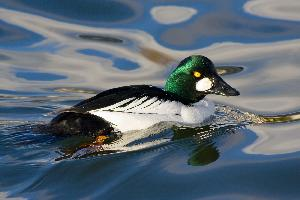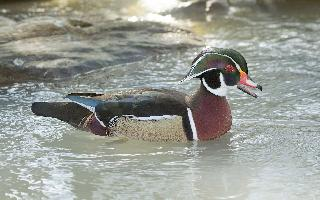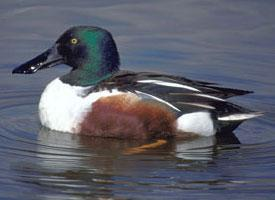
Poids et mesures
| Longueur | de 40 à 48 cm |
|---|---|
| Poids | de 600 à 1300 g |
| Envergure des ailes | de 77 à 83 cm |
Description de l'animal
The Common Goldeneye (Bucephala clangula) is a captivating species of duck belonging to the waterfowl family Anatidae. It is a medium-sized bird, characterized by its striking appearance and unique behaviors. This species is widely distributed across the northern regions of Europe, Asia, and North America, favoring cold climates and making remarkable migratory journeys to warmer areas during the winter months.Physical Description:
The Common Goldeneye is easily identifiable by its distinctive golden-yellow eyes, from which it derives its name. Adult males display a glossy greenish-black head with a prominent white spot near the base of the bill. Their bodies are predominantly white with black back and a white belly, creating a stark contrast that is visually striking. The females, on the other hand, have a more subdued appearance with brownish-gray plumage, a lighter head often described as chocolate brown, and a smaller white patch near the bill. Both sexes have bright orange-yellow feet and a relatively short, pointed bill that is more darkly colored in males.
Size and Behavior:
The average length of the Common Goldeneye ranges from 40 to 50 cm (16 to 20 inches), with a wingspan of approximately 60 to 80 cm (24 to 31 inches). These birds are known for their agility both in the air and underwater. They are excellent divers, using their powerful legs to propel themselves in pursuit of prey. Their diet primarily consists of aquatic invertebrates, small fish, and various plant materials.
Reproduction and Nesting:
The breeding season for the Common Goldeneye starts in late spring when they return to their northern breeding grounds. Unlike many other duck species, the Common Goldeneye often nests in tree cavities left by woodpeckers or in nest boxes if available. The female alone incubates the eggs, which number between 6 to 10, for about 28 to 32 days. Remarkably, the ducklings are capable of leaving the nest and following their mother to water just one day after hatching, showcasing an incredible level of precocity.
Conservation Status:
Currently, the Common Goldeneye is classified as Least Concern by the International Union for Conservation of Nature (IUCN), indicating that it does not face any immediate threat of extinction. This status is largely due to its wide distribution and relatively stable population sizes. However, habitat degradation, particularly the loss of suitable nesting sites due to deforestation, remains a concern for the species' long-term wellbeing.
In conclusion, the Common Goldeneye is a fascinating and resilient species with distinctive features and behaviors that make it a subject of interest for birdwatchers and conservationists alike. Its ability to thrive in harsh climates, coupled with its striking appearance and intriguing life history, underscore the incredible diversity and adaptability of the world's avian fauna.
Animaux similaires
Nouvelles photos d'animaux
Top 10 des animaux
- Dolphin gull (Leucophaeus scoresbii)
- Diana monkey (Cercopithecus diana)
- Moustached guenon (Cercopithecus cephus)
- Galápagos tortoise (Geochelone nigra complex)
- Japanese macaque (Macaca fuscata)
- Stone loach (Barbatula barbatula)
- Russian tortoise (Testudo horsfieldii)
- Greek tortoise (Testudo graeca)
- Common flying dragon (Draco volans)
- Vendace (Coregonus albula)


